1 Introduction
“There is no need to arrange communication cables at the site, the construction cost is low, and the mobile operation and maintenance within the station can be realized...†4G wireless communication seems to have many irreplaceable advantages in the application of photovoltaic power stations. However, the ideal is very full, but the reality is very skinny. Photovoltaic power plants have large data volumes, many monitoring nodes and relatively dispersed, and there are various high-voltage signal interferences in the field. There are many reasons that have brought great challenges to the operation stability and reliability of 4G wireless monitoring systems, especially scheduling reliability. .
After a field trip to a photovoltaic power plant in northwest China, the author discovered that after the grid-connected operation of the 100MW power plant for one year, the system still reported 60,387 alarm records in one month, of which more than 30% were communication failures. There was no coincidence. The author recently visited a photovoltaic power station in Inner Mongolia. At the same time, similar phenomena were discovered. If you consider the unfavorable factors such as high initial investment cost and later professional operation and maintenance, 4G wireless communication seems to have become a gimmick in the application of photovoltaic power plants.
What is the pros and cons of 4G wireless communication monitoring solutions? The author then takes you from the perspective of professional technology to reveal your true colors!
2 PV power plant monitoring system architecture
Photovoltaic system wired communication scheme and 4G wireless communication scheme system topology is shown as in Fig. 1.
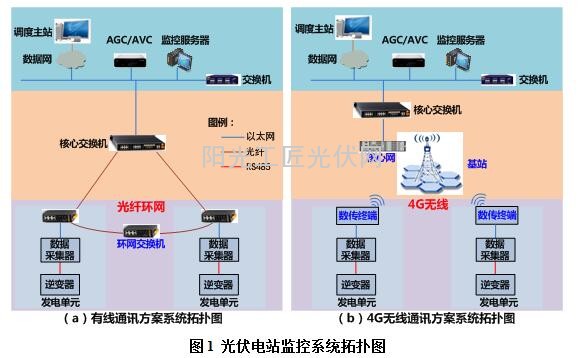
In the wired solution, each power generating unit internally outputs and forms a ring network in the form of optical fibers, and uploads the data to the monitoring center through the core switch. In the 4G wireless communication scheme, a wireless base station needs to be built in the power station, and each photovoltaic unit passes through the wireless and base stations. For communication, the core network equipment in the base station then converts the wireless signal into a wired signal and uploads it to the monitoring center.
3 Reliability Analysis
4G wireless transmission rate is low, vulnerable to obstacles such as hills
The optical fiber communication capacity is large, the transmission rate can reach 10000Mbps, and the communication channel bandwidth that 4G wireless scheme can adopt is maximum is only 10MHz, the theoretical communication speed is only 40Mbps, therefore, the transmission speed of 4G wireless communication is much lower than the wired communication. And the wireless network is vulnerable to the influence of structures such as buildings, trees, and other obstructions, which impedes the transmission of electromagnetic waves. Not all corners can be covered. For example, the hills can only be achieved by automatic speed reduction to achieve a seamless wireless connection. Connected, it will need to lose the transmission rate!
For large-scale power plants, the area is relatively large, and the digital transmission terminal of the most distant square matrix is ​​far away from the base station, and it is easily lost during signal transmission, resulting in communication failure. Therefore, in large desert power station or hill power station, in order to prevent the signal from being blocked and affect communication and other reasons, the wireless receiving base station is installed on the spot in the center of the collection square, and then is led to the centralized control room through a long distance optical fiber, as shown in Figure 2. Show.
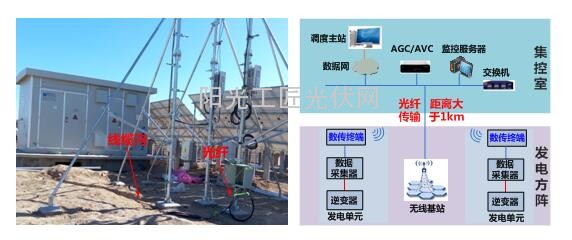
Figure 2 The wireless receiving base station is placed in a square matrix and the signal is transmitted to the centralized control room through the optical fiber
4G wireless solution has poor anti-electromagnetic interference and is easily affected by high voltage wires in photovoltaic power stations
The transmission signal of optical fiber communication is light instead of electricity. Not only is the loss small when the signal is transmitted, but it is not interfered by strong electromagnetic fields generated by the high-voltage wires in the plant. At the same time, the fiber ring network can automatically recover services in the event of an unexpected network failure. The network has strong survivability, the self-healing time is less than 20 ms, and the communication link is stable and reliable.
The wireless system is poor in anti-electromagnetic interference and it is easy to generate adjacent-channel interference and inter-modulation interference. According to a wireless test conducted by China Mobile in a certain area of ​​Guangzhou, the uplink throughput of the residential area is 37% to 47% due to intermodulation interference among antennas. The decline in throughput will cause important data to be reported inaccurately, resulting in communication links under severe conditions. Interrupted.
At the same time, the station's wireless signal is not only the "victim" of the interference, but it may also become a "pollution source," causing interference to other wireless signals around the station and even affecting aviation.
4G wireless solution has poor anti-electromagnetic interference and is vulnerable to bad weather
Fiber-optic communications use optical fibers as the transmission medium, buried under the ground, and not affected by the weather. The 4G wireless signal is susceptible to thunderstorm weather. According to the British "Focus" monthly report, dampness will weaken radio waves. Under normal circumstances, the propagation speed of radio waves in rain and snow is about 3/4 of that in sunny weather. The penetrating power is weakened and the transmission range is reduced. September 13, 2006 Australian News Network reported: US researchers said that thunderstorms on the earth can interfere with radio transmissions and signal transmission from communications equipment, which can easily lead to temporary disruption of wireless networks and even damage to outdoor wireless equipment.
Poor data security for 4G wireless solutions
The wavelength of the light wave used in optical fiber communication is very short, the frequency is very high, the transmission band is very wide, it is easy to use digital communication, digital encryption can be performed, and the optical signal is transmitted only in the optical zone, and basically no “leakage†of light occurs. Sound interference, high data security.
Wireless signals travel in an open space. As long as wireless access points (APs) cover the range, the terminals can receive wireless signals. Like the radio stations in anti-Japanese films, the signals are easily monitored and result in data. Give way.
Even the most reliable encryption method can easily be attacked by hackers.
With the continuous increase in the installed capacity, photovoltaic power generation as an important part of the multi-energy interconnected system, its operational safety requirements are getting higher and higher. The photovoltaic power plants monitored by the 4G wireless scheme have serious potential safety problems in power production.
4G wireless scheme scheduling reliability is poor
The 4G wireless communication scheme has susceptibility to interference in engineering practice, slow data transmission, and even communication interruption and other issues, which directly affect the real-time and stability of power grid dispatch.
The power grid companies in some regions have separately issued measures for the management of photovoltaic power plant voltage and reactive power regulation. They clearly stipulate that the communication links between the inverters inside the station—the communication cabinet—the monitoring back-end should use optical fiber communication and receive AGC/AVC scheduling. The response time of the command or output plan curve should not exceed 10 s. Moreover, the dedicated wireless frequency band needs to apply to radio regulatory agencies in various places. It is difficult and there is no corresponding standard for the use of wireless in the industry. The legitimacy of the wireless frequency band is questioned.
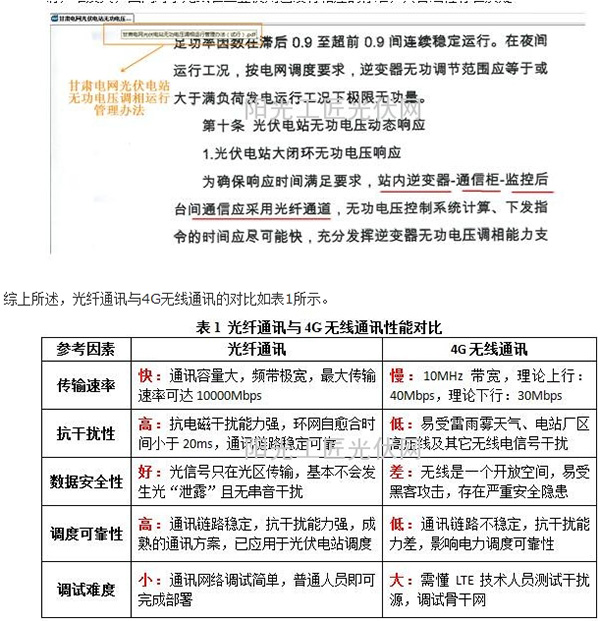
4G wireless solution has poor performance in field applications
When the author visited a northwestern photovoltaic power station in China, he discovered that the photovoltaic power plant used a 4G wireless communication scheme provided by a company. After the power station was connected to the network for one year, the system still reported 60,387 alarm records in a month, of which more than 30% were communication failures. As shown in Figure 3.
Coincidentally, the same thing happened to the author's recent inspection of a power station in Inner Mongolia. Since the power station was connected to the grid in 2014, the wireless monitoring system used in the power plant has continued to be a problem, with an average of 3,000 failures reported per day, most of which are equipment. communication fail. The troubles of the wireless network fault are difficult to find. When the equipment is used for monitoring and debugging, the fault may not be repeated. If the fault is not monitored, the fault will occur again. The wireless manufacturer's technicians still have problems in on-site debugging for a few months. It is difficult to debug and requires high professional standards. It brought huge workload and risks to the operation and maintenance of the power station in the later period, which increased the operation and maintenance costs.
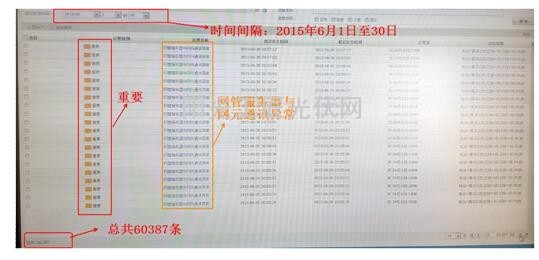
Fig. 3 Monitoring background alarm screen of a northwest photovoltaic power plant
4 Investment Cost Comparison
4. The initial investment of the 4G wireless scheme of the 150MW power station is 1.23 million higher than that of the wired solution
For wired communication solutions, if you consider that the power station has video data requirements and bandwidth limitations, 10 to 15 power generation units can be used to form a fiber ring network. Taking a 50MW photovoltaic power station as an example, the author assumes that each 10MW of a 50MW photovoltaic power station forms a fiber ring network. According to the system design and the topology diagram of the monitoring system shown in Figure 1, two power transmission units are connected to the monitoring center. The main equipment configuration list and costs are shown in Table 2.
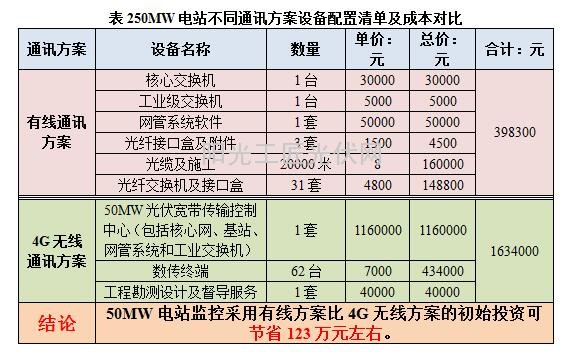
The initial investment of the 50 MW photovoltaic power station adopting the 4G wireless communication scheme is higher than the initial investment of the optical fiber Ethernet wired communication scheme by about 1.23 million yuan, which is equivalent to an increase of 2.4 points/W initial investment.
In addition, the 4G wireless scheme requires the engineering survey and design of the wireless network to be completed in the early stage. In the mid-commissioning stage, special technicians are required to perform the interference source test and debug the backbone network. The communication base station and the data transmission terminal need to be powered by an external power supply. Power selection and construction wiring costs. In the wired solution, the communication line layout can share a cable channel with the power line, which does not require additional construction wiring costs. The cost comparison in Table 2 shows that the cable solution is lower than the initial investment in the 4G wireless solution, even considering the cost of the cabling construction.
4.24G wireless solution costs 1.02 million more than the cable program
Labor cost comparison. The cable technology is mature, debugging is simple, and no professional technical personnel are required for operation and maintenance in the later period. The wireless network requires professional and technical personnel with knowledge of the network to carry out network equipment operation and maintenance. The personnel quality requirements are relatively high, which intangibly increases the manpower of the power station operation and maintenance. cost. The larger the scale of photovoltaic power plants, the more facilities in the network and the more complex the transmission structure, the more difficult and the scope of maintenance of network equipment will increase, and labor costs will increase further.
If 50MW power station photovoltaic power station employs only one professional who understands the network, the annual salary is estimated to be 40,000 yuan higher than that of ordinary operation and maintenance personnel. The operational cost of the 4G wireless solution within the 25-year lifecycle of the photovoltaic power plant will be increased by 1 million yuan over the wired solution. .
Equipment replacement cost comparison. For a power station, there are many wires buried in the ground, and fiber is only a small part of them. Marks are usually made on the spot to prevent damages in later construction. Therefore, the probability of fiber being cut off is extremely low. At the same time, the main equipment switches used in the cable solutions are mature products that have been applied for a long time, have low failure rates, low prices, and low equipment replacement investment costs.
In addition, some devices, such as antennas, in radio remote units (RRUs) of wireless communication base stations are installed outdoors. Even if they do not consider the destruction of natural disasters such as lightning, they generally need to be replaced in 7 years or so. For a 25-year life cycle The power station needs to be replaced at least 3 to 4 times. If the replacement is calculated at 30,000 yuan, the investment cost of the equipment in the later operation and maintenance will be 90,000 to 120,000.
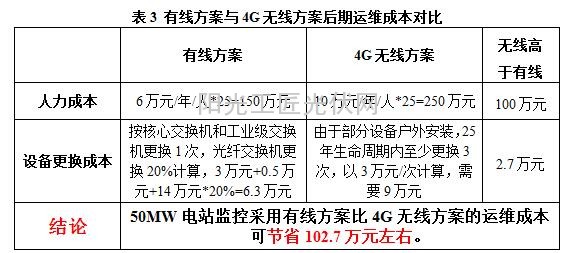
Considering only the operation and maintenance labor costs and outdoor antenna replacement, a 50MW photovoltaic power station, the operation and maintenance cost of the 4G wireless solution is about 1,027,000 higher than that of the wired solution, and from Table 2 it can be seen that the power generation unit of the cable solution is in the monitoring center. The initial investment is only about 400,000 yuan. Therefore, even if some manufacturers on the market currently use the free gift method in order to promote the 4G wireless communication solution of the photovoltaic power station, it is still uneconomical from the perspective of later operation and maintenance costs.
5 Conclusion
I believe that through the technical analysis of the above professional perspective, you can see at a glance. 4G wireless monitoring solutions have many disadvantages, such as high investment costs, unstable system operation, high communication failure rate, and failure to respond to power system scheduling requirements in real time. This makes them a gimmick in photovoltaic power plant applications, providing reliability and future operation for power plants. Operation and maintenance have brought huge hidden troubles.
In contrast, the cable solution not only has high reliability, but also has a low investment cost and is easy to operate and maintain in the later period. It is still the mainstream monitoring solution for the global photovoltaic industry. This is true even in Europe and the United States, where the human cost is very high.
Lighting Accessories,12V Power Box,Online Led Controller,Led Light Dimmer
Shen zhen SH LED Technology Co.,Ltd , https://www.pixellightsolutions.com